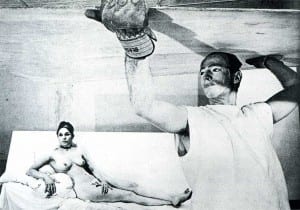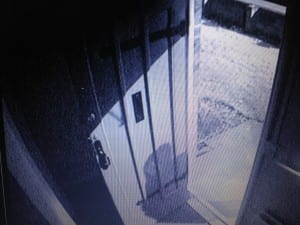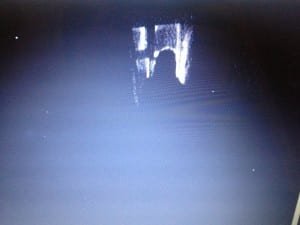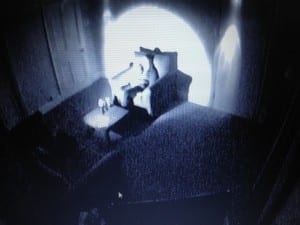Is it socially acceptable to be naked in a performance? Where does the line sit separating performance and real life? Does this line change when the performer is naked? These are all questions we have to deal with when creating this performance in the bedroom.
(http://artintelligence.net/review/?p=529 :accessed 06/04/13)
It would be “useful to distinguish among approved, liminal, and subversive spaces with regard to the acceptability of nude performance.” ((Jones, MT (2010) ‘Mediated Exhibitionism: The Naked Body in Performance and Virtual Space’, Sexuality & Culture, 14, 4, pp. 253-269.)) With regards to the cupboard, it is not a subversive space because no one has specifically denied the right to be naked in a cupboard. In an everyday society I doubt it would be considered an approved space for nudity.
It could be considered a liminal space. It has a purpose (storage) but it is never really considered to be a room of its own. “Liminal spaces are experimental zones where social roles and relationships are tested and redefined.” ((Jones, MT (2010) ‘Mediated Exhibitionism: The Naked Body in Performance and Virtual Space’, Sexuality & Culture, 14, 4, pp. 253-269.)) The socially established roles of performer and audience member are tested in our performance. The eye contact that is made while the narrative is playing through the headphones puts the audience member in a vulnerable position. They are used to being passive; simply sitting and watching others perform. A cupboard in a bedroom is usually there to store clothes, which implies the opposite of nakedness. Our aim is to shock the audience and so by taking a place not usually associated with nudity and filling it with a naked female should achieve this goal.
“Nudity is often associated with freedom from the constraints and demands of culture.” ((Jones, MT (2010) ‘Mediated Exhibitionism: The Naked Body in Performance and Virtual Space’, Sexuality & Culture, 14, 4, pp. 253-269.)) We also challenge this notion, by alluding to the prospect of bondage using ties and gags. Nudity in plays is often approached at a very domesticated level, so it seems normal to an audience and a lot less shocking. In an article by the BBC on nudity and performance one actor comments; “We were expecting a lot more guffaws and giggles and awkwardness, but because it’s so domesticated and so real the audience feels quite relaxed by that point.” ((Phoebe Waller-Bridge in: Masters, Tim (2013) ‘Actors Reveal Challenges of Stage Nudity’, BBC News, 6. March.)) Our performance aims for two different reactions. At no point, do we aim to make any audience member feel comfortable. However, it will be a very different experience for males and females. The females will sympathise with the vulnerable girl in the cupboard and there is no dominant power source. With the male audience members, we want to make them feel as uncomfortable as possible and want to reverse the power so the naked female is in control. This is an unexpected turn and so will prevent the viewer from relaxing into the situation.
Getting the correct balance of nudity and performance is important. The nudity must serve a purpose, whether it is to shock the audience or simply to make a scene more ‘real’. For example, you couldn’t perform a scene in a bath being fully clothed: it would look unrealistic. Using Carolee Schneemann as an example, her work was extremely avant garde and not always received well. In academic books, she doesn’t tend to be mentioned other than a few of her early works. She was considered a performance artist and nudity became like a trademark for her work.
“Often, her focus on the body, on sex, was seen as a problem both by feminists and by the (male) audience.” ((Sundberg, M (2011) ‘A One-Work-Artist? Carolee Schneemann and the Reception of her Work’, Konsthistorisk Tidskrift, 80, 3, pp. 168-179.))
This is a lot to do with the male and female gaze. It would be considered normal for the male audience to accept her work as it is more common to have a male gaze on the female form. However, her work was rejected and criticised by men as well as women. She wanted to break down the stereotype of women being the ‘image’. Trying to portray this message in a time where men were still very much the dominant figures in society would have provoked critique.
“The line is very fine between making this point clear to the audience, and once again being turned into an object by the still powerful male gaze.” ((Sundberg, M (2011) ‘A One-Work-Artist? Carolee Schneemann and the Reception of her Work’, Konsthistorisk Tidskrift, 80, 3, pp. 168-179.))
This is something that we considered with our performance. We want to shift away from the male gaze and make this naked female form in the cupboard gain total control over the male viewer. When creating and recording the narrative we needed to make sure our voices were strong enough to gain instant control over the audience member. Our eyes once the blindfold is removed will also help this process.




